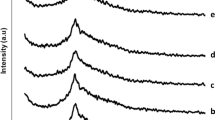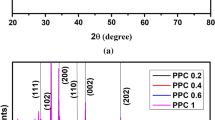Abstract
A complex of polyvinyl alcohol (PVA) with copper hydroxide was used as a precursor to obtain polymeric copper oxide through thermal decomposition. The absence of Cu(OH)2 crystalline phase was observed for the component ratio up to 1 Cu(OH)2 molecular unit to 3 PVA residuals. The formation of crystalline copper oxide was not observed after the dehydration of this material. UV–VIS and IR spectroscopy, and computational modeling were used to study the structure and properties of the obtained materials. A comparison with other similar materials was drawn. It was found that experimental data are in general accordance with the computations based on the polymeric model for copper hydroxide/oxide as a component of hybrid interpolymeric complex with PVA. A distinctive feature observed for polymeric copper oxide is strong broadening of the optical absorption band at 400 nm. It is suggested that this effect is caused by strong electron–phonon interaction, which is also responsible for superconductivity of copper oxide based systems.








Similar content being viewed by others
References
Shuji Saito und Haruhiko Okuyama. Die Adsorption von Kupfer auf Polyvinylalkohol. Kolloid Z. 139(3), 150–155 (1954)
H. Yokoi, S. Kawata, M. Iwaizumi, Interaction modes between heavy metal ions and water-soluble polymers. 1. Spectroscopic and magnetic reexamination of the aqueous solutions of cupric ions and poly(vinyl alcohol). J. Am. Chem. Soc. 108, 3358–3361 (1986)
I.Y. Prosanov, N.V. Bulina, A.C. Yu, Hybrid material polyvinyl alcohol-copper oxide and its electrical properties. Phys. Solid State 54(8), 1699–1703 (2012)
R.W. Antony, Solid State Chemistry and Its Applications (Wiley, London, 1984)
Y. Cudennec, A. Lecerf, The transformation of Cu(OH)2 into CuO, revisited. Solid State Sci. 5, 1471–1474 (2003)
Yu Li, X.-Y. Yang, J. Rooke, G. Van Tendeloo, B.-L. Su, Ultralong Cu(OH)2 and CuO nanowire bundles: PEG200-directed crystal growth for enhanced photocatalytic performance. J. Colloid Interface Sci. 348, 303–312 (2010)
S.K. Shinde, D.P. Dubal, G.S. Ghodake, D.Y. Kim, V.J. Fulari, Nanoflower-like CuO/Cu(OH)2 hybrid thin films: synthesis and electrochemical supercapacitive properties. J. Electroanal. Chem. 732, 80–85 (2014)
S.C. Lee, S.-H. Park, S.M. Lee, J.B. Lee, H.J. Kim, Synthesis and H2 uptake of Cu2(OH)3Cl, Cu(OH)2 and CuO nanocrystal aggregate. Catal. Today 120, 358–362 (2007)
A.R. Hajipour, F. Mohammadsaleh, M.R. Sabzalian, Copper-containing polyvinyl alcohol composite systems: preparation, characterization and biological activity. J. Phys. Chem. Solids 83, 96–103 (2015)
D.M. Ginsberg (ed), Physical Properties of High Temperature Superconductors (World Scientific, Singapore, 1989)
M. Sierka, Synergy between theory and experiment in structure resolution of low-dimensional oxides. Prog. Surf. Sci. 85, 398–434 (2010)
T. Takahama, S.M. Saharin, K. Tashiro, Details of the intermolecular interactions in poly(vinyl alcohol)-iodine complexes as studied by quantum chemical calculations. Polymer 99, 566–579 (2016)
I.Y. Prosanov, N.V. Bulina, K.B. Gerasimov, Complexes of polyvinyl alcohol with insoluble inorganic compounds. Phys. Solid State 55, 2132–2135 (2013)
I.Y. Prosanov, E. Benassi, N.V. Bulina, A.A. Matvienko, Structure and properties of self-assembling low-dimensional hybrid materials: the case of cadmium halides in polyvinyl alcohol. Curr. Inorg. Chem. 7(3), 155–161 (2017)
I.Y. Prosanov, E. Benassi, N.V. Bulina, Structure of hybrid interpolymeric complexes of zinc halides with polyvinyl alcohol. Curr. Appl. Polym. Sci. 2(1), 44–48 (2018)
I.Y. Prosanov, E. Benassi, Structure of hybrid interpolymeric complexes of polyvinyl alcohol and halides of second group elements. Adv. Mater. Sci. Eng. 2017, 4931082 (2017)
I.Y. Prosanov, S.T. Abdulrahman, S. Thomas, N.V. Bulina, K.B. Gerasimov, Complex of polyvinyl alcohol with boric acid: structure and use. Mater. Today Commun. 14, 77–81 (2018)
A.D. Becke, Density-functional thermochemistry. III. The role of exact exchange. J. Chem. Phys. 98, 5648–5652 (1993)
R. Ditchfield, W.J. Hehre, J.A. Pople, Self-consistent molecular orbital methods. 9. Extended Gaussian-type basis for molecular-orbital studies of organic molecules. J. Chem. Phys. 54(1), 724–728 (1971)
W.J. Hehre, R. Ditchfield, J.A. Pople, Self-consistent molecular orbital methods. 12. Further extensions of Gaussian-type basis sets for use in molecular-orbital studies of organic-molecules. J. Chem. Phys. 56(6), 2257–2261 (1972)
P.C. Hariharan, J.A. Pople, Influence of polarization functions on molecular-orbital hydrogenation energies. Theor. Chem. Acc. 28, 213–222 (1973)
P.C. Hariharan, J.A. Pople, Accuracy of AH equilibrium geometries by single determinant molecular-orbital theory. Mol. Phys. 27, 209–214 (1974)
M.S. Gordon, The isomers of silacyclopropane. Chem. Phys. Lett. 76, 163–168 (1980)
M.M. Francl, W.J. Pietro, W.J. Hehre, et .al. Self-consistent molecular orbital methods. 23. A polarization-type basis set for 2nd-row elements. J. Chem. Phys. 77, 3654–3665 (1982)
R.C. Binning, L.A. Curtiss, Compact contracted basis-sets for 3rd-row atoms—GA-KR. J. Comp. Chem. 11, 1206–1216 (1990)
J.-P. Blaudeau, M.P. McGrath, L.A. Curtiss, L. Radom, Extension of Gaussian-2 (G2) theory to molecules containing third-row atoms K and Ca. J. Chem. Phys. 107, 5016–5021 (1997)
V.A. Rassolov, J.A. Pople, M.A. Ratner, T.L. Windus, 6-31G* basis set for atoms K through Zn. J. Chem. Phys. 109, 1223–1229 (1998)
V.A. Rassolov, M.A. Ratner, J.A. Pople, P.C. Redfern, L.A. Curtiss, 6-31G* basis set for third-row atoms. J. Comp. Chem. 22, 976–984 (2001)
G.A. Petersson, A. Bennett, T.G. Tensfeldt, M.A. Al-Laham, W.A. Shirley, J. Mantzaris, A complete basis set model chemistry. I. The total energies of closed-shell atoms and hydrides of the first-row atoms. J. Chem. Phys. 89, 2193–2218 (1988)
G.A. Petersson, M.A. Al-Laham, A complete basis set model chemistry. II. Open-shell systems and the total energies of the first-row atoms. J. Chem. Phys. 94, 6081–6090 (1991)
S. Grimme, S. Ehrlich, L. Goerigk, Effect of the damping function in dispersion corrected density functional theory. J. Comput. Chem. 32, 1456–1465 (2011)
T. Yanai, D.P. Tew, N.C. Handy, A new hybrid exchange-correlation functional using the Coulomb-attenuating method (CAM-B3LYP). Chem. Phys. Lett. 393, 51–57 (2004)
C.M. Breneman, K.B. Wiberg, Determining atom-centered monopoles from molecular electrostatic potentials—the need for high sampling density in formamide conformational-analysis. J. Comp. Chem. 11, 361–373 (1990)
H.J. Bohórquez, C.F. Matta, R.J. Boyd, The localized electrons detector as an ab initio representation of molecular structures. Int. J. Quant. Chem. 110, 2418–2425 (2010)
E.R. Johnson, S. Keinan, P. Mori-Sánchez, J. Contreras-Garcia, A.J. Cohen, W. Yang, Revealing noncovalent interactions. J. Am. Chem. Soc. 132, 6498–6506 (2010)
J. Andres, S. Berski, J. Contreras-Garcia, P. Gonzalez-Navarrete, Following the molecular mechanism for the NH3 + LiH -> LiNH2 + H-2 chemical reaction: a study based on the joint use of the quantum theory of atoms in molecules (QTAIM) and noncovalent interaction (NCI) index. J. Phys. Chem. 118, 1663–1672 (2014)
P. Cacciani, P. Čermák, J. Cosléou, J. El Romh, J. Hovorka, M. Khelkhal, Spectroscopy of ammonia in the range 6626–6805 cm−1: using temperature dependence towards a complete list of lower state energy transitions. Mol. Phys. 18, 2476–2485 (2014)
M.J. Frisch, G.W. Trucks, H.B. Schlegel, et al., Gaussian 09, Revision D.01 (Gaussian, Inc., Wallingford, 2013)
I.Yu.. Prosanov, N.V. Bulina, Polymeric sulfides CdS, CuS, and NiS in polyvinyl alcohol matrix. Phys. Solid State 56, 1270–1272 (2014)
H.R. Oswald, A. Reller, H.W. Schmalle, E. Dubler, Structure of copper(II) hydroxide, Cu(OH)2. Acta Cryst. C46, 2279–2284 (1990)
N. Mott, E. Davis, Electronic Processes in Non-crystalline Materials (Oxford University Press, Oxford, 1971)
M. Abdelaziz, M.M. Ghannam, Influence of titanium chloride addition on the optical and dielectric properties of PVA films. Phys. B 405, 958–964 (2010)
H. Abdullah, N.A.N. Azmy, N.M. Naim, A.A. Hamid, S. Idris, Synthesis and fabrication of ZnO–CuO doped PVA and ZnO–PbO doped PVA nanocomposite films by using γ-radiolysis and it’s microbial sensor application. J Sol Gel Sci. Technol. 74(1), 15–23 (2015)
D. Curie, Luminescence in Crystals (Wiley, London, 1963)
R.F.W. Bader, H. Essen, The characterization of atomic interactions. J. Chem. Phys. 80(5), 1943–1960 (1984)
R.F.w. Bader, Atoms in Molecules. A Quantum Theory (Oxford University Press, Oxford, 1994)
R.F.W. Bader, A quantum-theory of molecular-structure and its applications. Chem. Rev. 91, 893–892 (1991)
R.A. Boto, J. Contreras-Garcia, J. Tierny, J.-P. Piquemal, Interpretation of the reduced density gradient. Mol. Phys. 114, 1406–1414 (2016)
Y. Zhang, H. He, K. Dong, S. Zhang, A DFT study on lignin dissolution in imidazolium-based ionic liquids. RSC Adv. 7, 12670–12682 (2017)
Acknowledgements
The Siberian Supercomputer Center of the Siberian Branch of the Russian Academy of Sciences (SB RAS) is gratefully acknowledged for providing supercomputer facilities.
Author information
Authors and Affiliations
Corresponding authors
Electronic supplementary material
Below is the link to the electronic supplementary material.
Rights and permissions
About this article
Cite this article
Prosanov, I.Y., Benassi, E., Bulina, N.V. et al. Polymeric Copper Oxide: Preparation and Investigation of Its Structure and Optical Properties. J Inorg Organomet Polym 28, 2328–2335 (2018). https://doi.org/10.1007/s10904-018-0897-5
Received:
Accepted:
Published:
Issue Date:
DOI: https://doi.org/10.1007/s10904-018-0897-5




